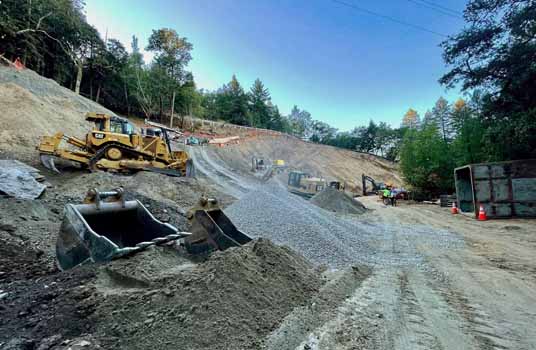by Ann Thomas
Pine Mountain Tunnel, an integral part of Marin County’s water conveyance system for more than a century, was converted to a major water storage facility for Ross Valley water in 1971, but will soon be decommissioned altogether. The tunnel, above the Cascade area of Fairfax, will be replaced by two 2-million-gallon concrete tanks located along the upslope (west) side of ConcretePipe Road, near Bolinas and Sky Oaks roads on Water District property.
According to Jack Gibson’s book, Mount Tamalpais and the Marin Municipal Water District, planning for the tunnel began in 1915—just three years after the new water agency held its first board meeting—as part of the Alpine Dam construction project. The young board, charged with forming an integrated supply and transmission system to serve a growing population, conceived of a new reservoir that would be created by constructing Alpine Dam at the confluence of Cataract and Lagunitas creeks. The reservoir water would be conveyed by gravity beginning with a four-mile concrete pipeline from the dam to the side of Pine Mountain. To continue the route, a tunnel was excavated with gas-powered pneumatic drills through the mountain. On the 1.760-fee-thigh mountain’s east side, pipes exited the tunnel and continue traveling downhill to Fairfax.
The tunnel is eight feet in diameter and 8,700 feet long, with a concrete lining six to 12 inches thick, and was an engineering marvel when it was built. Its capacity works out to be 3.2 million gallons.
Water currently stored in Pine Mountain Tunnel is later treated to meet all public safety standards at the water district’s Bon Tempe Treatment Plant, located on the Mount Tam watershed, from where it flows to users in the Ross Valley. The necessity for tunnel closure and replacement is driven by the tunnel’s deterioration due to age, along with the growing need to have a larger water supply in storage for day-to-day and emergency usage.
Leakage of water from the tunnel has been augmenting the flow of Carey Camp Creek, a tributary of San Anselmo Creek, and it will be interesting to see if closing this source affects creek conditions for fish.
A 2009 risk assessment of the tunnel revealed cracks, calcium deposits, holes in the wall, and groundwater infiltration. This deterioration led state regulators to require either removal of the facility from the system or its complete repair. In addition, a two-year Ross Valley water supply master plan, finalized in 2022, estimated that the water storage need was far greater than that available, partly because of heightened fire risk. The tunnel replacement tops a list of about two dozen major capital improvement projects now in various stages to upgrade or replace aging district infrastructure
Pine Mountain Tunnel and Ross Reservoir, on the side of Bald Hill, together comprise most of the Ross Valley’s water storage. Ross Reservoir holds about one million gallons, a third of the tunnel’s capacity.
Excavation and site preparation for the new tanks began this past fall. The project entails concrete foundation slabs, concrete walls and roofs, and site drainage facilities; steel pipes up to 30 inches in diameter; valves to connect each of the new tanks with the existing 30-inch pipe that follows Concrete Pipe Road; and perimeter fencing and motion sensor lighting. Excavated spoils are being deposited near the Meadow Club, at Bullfrog Quarry and other already disturbed sites on district property.

The first phase of the project involves grading and the installation of a retaining wall in preparation for construction of the tanks. This work will continue through the end of January 2024, then pause through spring. The first phase is expected to be complete by the end of January 2025. Periodic road and trail closures and vehicle parking restrictions will be implemented during the construction.
No project-related activity is anticipated at the Pine Mountain Tunnel site, other than draining the tunnel when the replacement tanks are in use. At that time water will be moved from Pine Mountain to the new tanks. There has not been a decision about whether the tunnel could have another use or be filled in.
